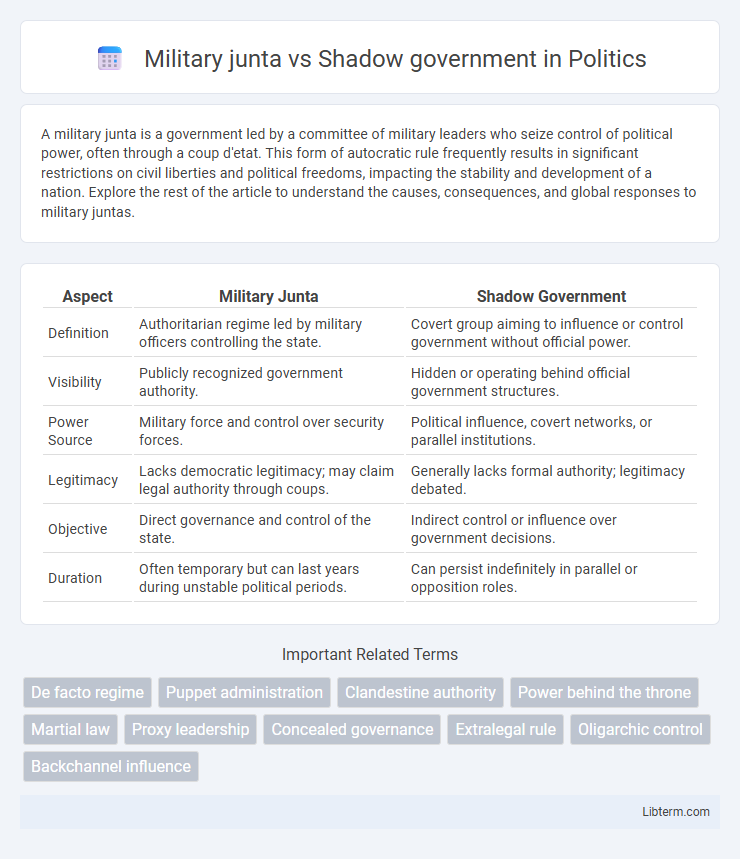A military junta is a government led by a committee of military leaders who seize control of political power, often through a coup d'etat. This form of autocratic rule frequently results in significant restrictions on civil liberties and political freedoms, impacting the stability and development of a nation. Explore the rest of the article to understand the causes, consequences, and global responses to military juntas.
Table of Comparison
| Aspect | Military Junta | Shadow Government |
|---|---|---|
| Definition | Authoritarian regime led by military officers controlling the state. | Covert group aiming to influence or control government without official power. |
| Visibility | Publicly recognized government authority. | Hidden or operating behind official government structures. |
| Power Source | Military force and control over security forces. | Political influence, covert networks, or parallel institutions. |
| Legitimacy | Lacks democratic legitimacy; may claim legal authority through coups. | Generally lacks formal authority; legitimacy debated. |
| Objective | Direct governance and control of the state. | Indirect control or influence over government decisions. |
| Duration | Often temporary but can last years during unstable political periods. | Can persist indefinitely in parallel or opposition roles. |
Introduction: Defining Military Junta and Shadow Government
A military junta is a government led by a committee of military leaders who seize power through force, often suspending existing political structures. A shadow government operates covertly, composed of influential actors who manipulate or control political power behind the official administration. Both entities undermine democratic processes but differ in visibility and methods of authority exercise.
Historical Context: Origins and Evolution
Military juntas originated as authoritarian regimes where military leaders seize control, often during political instability, exemplified by the 1960s Latin American coups. Shadow governments, by contrast, emerge as clandestine networks operating behind the scenes to influence or replace official governments, with roots in wartime resistance groups and covert political opposition. Both entities evolved through historical contexts marked by struggles for power, often intertwining during periods of occupation, revolution, or civil conflict.
Structure and Organization of Military Juntas
Military juntas consist of high-ranking officers who collectively exercise political power, operating through a centralized command structure often dominated by a ruling council or committee. Their organization is hierarchical and disciplined, reflecting military protocols with decision-making concentrated among generals or senior officers. This structured arrangement contrasts with the more diffuse and covert nature of shadow governments, which function through clandestine networks rather than formalized military chains of command.
Characteristics and Functions of Shadow Governments
Shadow governments operate covertly, orchestrating political, economic, or social influence without official authority, often manipulating public policy through clandestine networks. Unlike military juntas that overtly seize power through force and direct control of armed forces, shadow governments maintain anonymity to preserve legitimacy while executing strategies behind the scenes. Their functions include intelligence gathering, propaganda dissemination, and influencing lawmaking to shape national or international agendas discreetly.
Power Acquisition: Methods and Legitimacy
Military juntas acquire power primarily through direct force, often via coups d'etat that dismantle existing governmental structures, establishing control through military hierarchy and coercion. Shadow governments, in contrast, gain influence covertly by manipulating political channels, intelligence networks, or social movements without overt military presence, often claiming legitimacy through allegiance to banned or exiled regimes. The legitimacy of military juntas is frequently contested internationally due to their undemocratic seizure of power, while shadow governments seek legitimacy by portraying themselves as custodians of lawful governance or national interest.
Impact on Governance and Civil Liberties
Military juntas seize control through force, often suspending constitutions and limiting political freedoms, resulting in centralized power and restricted civil liberties such as free speech and assembly. Shadow governments operate covertly, undermining official institutions by influencing policies behind the scenes, which can erode transparency and accountability in governance. Both structures negatively impact democratic processes, but military juntas impose more overt repression, while shadow governments create instability through lack of legitimacy and secretive control.
Domestic and International Perceptions
Military juntas often face domestic resistance due to their overt use of force and suspension of civil liberties, which can undermine their legitimacy among citizens while casting them as oppressive regimes internationally. Shadow governments operate covertly, shaping political outcomes behind the scenes, which may lead to domestic uncertainty and skepticism but allow for plausible deniability in the international arena. Both entities affect perceptions of stability and governance, influencing foreign diplomacy and internal political trust.
Case Studies: Real-World Examples
Military juntas have frequently emerged in countries like Myanmar and Egypt, where direct control of the armed forces led to overt authoritarian rule and suspension of civilian institutions. Shadow governments operate more covertly, often seen in cases like Venezuela or Syria, where opposition groups or parallel administrations seek to influence or replace existing regimes without formal power. These case studies highlight differing dynamics of power consolidation, legitimacy, and international recognition between military juntas and shadow governments.
Comparative Analysis: Stability and Effectiveness
Military juntas often provide rapid decision-making and enforce strict order, but their stability is frequently undermined by internal power struggles and resistance from civilian populations. Shadow governments tend to operate covertly, leveraging political influence and grassroots support to maintain continuity and legitimacy, which can enhance long-term stability but may lack immediate effectiveness in governance. Comparative analysis reveals that while military juntas excel in short-term control, shadow governments typically achieve greater effectiveness through adaptability and sustained popular backing.
Future Perspectives and Potential Outcomes
Military juntas often consolidate power through direct control of armed forces, leading to authoritarian regimes with limited political plurality, whereas shadow governments operate covertly to influence or replace official administrations. Future perspectives indicate that military juntas may face internal resistance and international sanctions, potentially resulting in prolonged instability, while shadow governments risk exposure and legal repercussions but can effectively orchestrate political transitions. Potential outcomes include either enhanced autocratic stability under military rule or a covert shift towards reformed governance driven by shadow entities exploiting political vulnerabilities.
Military junta Infographic

 libterm.com
libterm.com